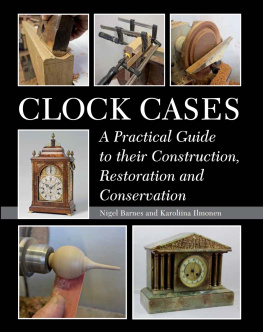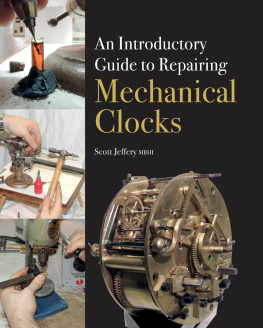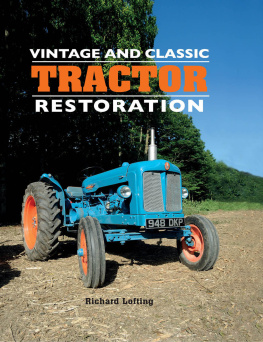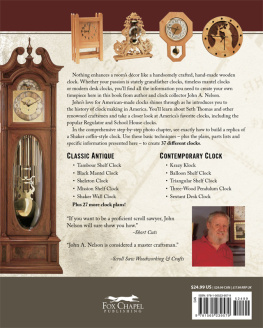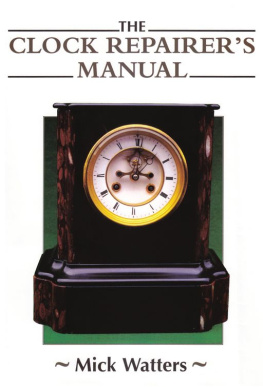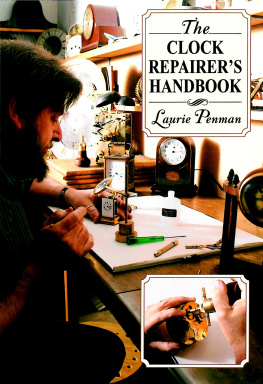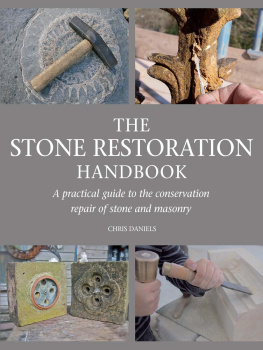
CLOCK CASES
A Practical Guide to their Construction, Restoration and Conservation
Nigel Barnes and Karoliina Ilmonen

First published in 2015 by
The Crowood Press Ltd
Ramsbury, Marlborough
Wiltshire SN8 2HR
www.crowood.com
This e-book published 2015
Nigel Barnes and Karoliina Ilmonen 2015
All rights reserved. No part of this publication may be reproduced or transmitted in any form or by any means, electronic or mechanical, including photocopy, recording, or any information storage and retrieval system, without permission in writing from the publishers.
British Library Cataloguing-in-Publication Data
A catalogue record for this book is available from the British Library.
ISBN 978 1 78500 024 9
Disclaimer
The practical workshop procedures and the tools and equipment used by those involved in clock case construction, restoration and conservation are potentially dangerous. All equipment and tools employed in this work should be used in strict accordance with both current health and safety regulations and the manufacturers instructions.
The author and the publisher do not accept any responsibility in any manner whatsoever for any error or omission, or any loss, damage, injury, adverse outcome, or liability of any kind incurred as a result of the use of any of the information contained in this book, or reliance upon it. If in doubt about any aspect of the construction, restoration and conservation of clock cases, readers are advised to seek professional advice.
Throughout this book craftsman, he, him and his are used as neutral pronouns and as such refer to males and females.
Photographs by Nigel Barnes except where otherwise stated.
Preface
This book is a sequel and companion to Maintaining Longcase Clocks An Owners Guide to Maintenance, Restoration and Conservation and is likewise aimed at the amateur clock owner and the aspiring professional. While that book was restricted in its scope to just one type of clock, this is intended as a source for anyone working on clock cases. It covers the more frequent types of cases of clocks made up to about one hundred years ago or less in other words, clock cases that would now be considered as antique in the usual meaning of the word. Because we work in conservation and restoration, we do not offer advice about modern designs for new clocks.
As the title suggests, this book is aimed at the practitioner everyone from the amateur clock enthusiast to a professional horological service provider rather than the collector. As a result, the historical background material provided is just enough to put the clock cases into their social and historical context or setting. Nevertheless, it is inevitable that we touch on the wider subject of how antiques and cultural heritage objects might be preserved for future generations to enjoy and learn from. Over the centuries, clocks and clock cases have been made to reflect a wide range of status, quality and value; the same sorts of value judgements and decisions about preservation and restoration that apply to other forms of cultural heritage object apply equally to clock cases.
My co-author in this book is Karoliina Ilmonen, a bright and energetic clock restorer and conservator. She has contributed modern thinking based on her formal training and comprehensive understanding of the principles of conservation in horology.
Karoliina and I are not museum-based conservators. We both provide professional services in the horological sector as clock and clock-case restorers and conservators, so we are familiar with the conflicts between available budget, preservation and usage. We often argue about how best to apply the principles of conservation and how to make those real-world compromises that will best suit our clients while, as far as possible, preserving the clocks that are temporarily entrusted to us. Karoliina is a theoretical perfectionist in her approach to her conservation work and I am more of a pragmatist, aware of the clients budget and the foreseeable future. The fact that we do not always disagree indicates that, for any clock, a number of conservation or restoration approaches are possible, each with a separate outcome.
People have always been fascinated by old items and, with the rise of mass production in the early twentieth century, formalized ideas about conservation in general began to develop. The preservation of horological heritage was always a slightly different case because it was to some extent obstructed by a contrary groundswell of conservative, pragmatic clock-menders whose primary objective was the maintenance of domestic time-keeping by whatever means necessary.
Since those early conservation days, clock cases have remained in a sort of no-mans land between the horology and antique furniture sectors. This advice given by the British Horological Institute in its 1995 publication, Conservation of Clocks and Watches (ed. Peter B. Wills), asserted that clock case restoration was a specialized field and that clock restorers who had no previous training or experience in that area should not become involved in it. From the other side of the fence, The British Antique Furniture Restorers Association lists clock movements and clock dials among its services but not clock cases. Neither the European Confederation of Conservator-Restorers Organizations (ECCO) nor the UK Institute of Conservation (ICON) are aware of any conservation guidelines that are specific to clock cases. And, while the British Horological Institute recommends avoidance, the Antiquarian Horological Society offers a bursary for conservation work, but gives no conservation advice for clocks, let alone clock cases.
The apparent absence of specific guidance about clock-case restoration should not be a matter for immediate concern. Clock cases are, after all, cultural heritage objects for which universal guidelines apply. Drawing on as many sources as possible, our aim has been to set out clear practical advice that is straightforward to follow and will be more or less in harmony with the sorts of best-practice guidelines that will surely play an increasingly significant part in the way clock cases are preserved for future generations.
Conservation and restoration start with identification and historical assessment. To quote from Herbert Cescinsky, The history of a nations handicrafts is the history of a people, and its art works mark the measure of its culture and education. With the furniture of the various periods we enter the homes of their everyday life.
Although our book is more concerned with restoration and conservation, we accept that advice on making new clock cases is both necessary and appropriate. The reason for that apparent discrepancy is that conservators must consider the long-term preservation of clocks. In the case of a clock that has somehow lost its case, the preferred preservation route is the construction of an appropriate replacement case. This will ensure that the clock remains intact as an identifiable object and should also convey an impression or sense of the original.
We discuss the main types of clock case, referring to their historical background and evolutionary history before dealing with the specifics of construction and restoration. Clock cases made from materials other than wood figure quite prominently this is an area that otherwise is only really covered by special interest groups, mostly through the internet.
The subject of clock cases is inseparable from the wider subject of clocks but we describe clock movements only in terms of physical characteristics, the dimensions and properties that influence the design and construction of their cases.
Next page
